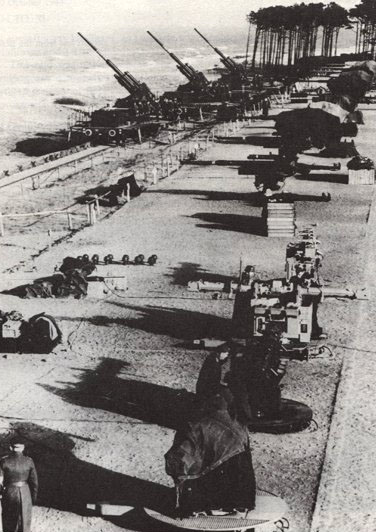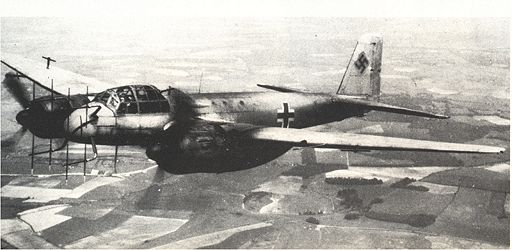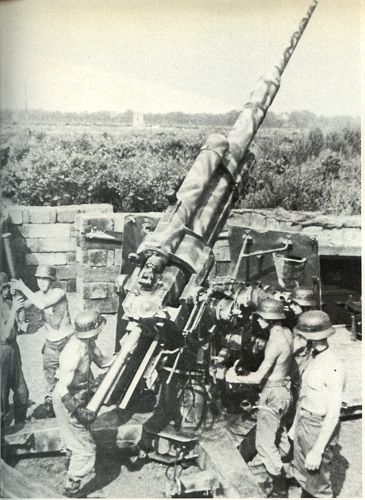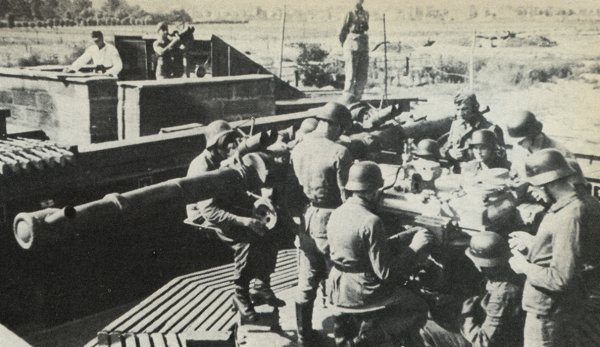
A railway-mounted Flak battery on the coast. The white rings around the barrels of the main guns represent eleven RAF bombers claimed as shot down by this battery - a Wellington, a Stirling, six Halifaxes and three Lancasters.

Albert Speer comments in his book, he could not possibly have spared the enormous amount of skilled, semi–skilled and unskilled labour for such an ambitious project as the manufacture of the atomic bomb from the necessity of using these people to repair the bomb damage to the German armament industry. That was in June 1942 and of course that damage went crescendo after that.
His next statement that as Minister of Armament, which he had then become, that by the end of 1943, when we were really getting going with about a quarter of the force we asked for and the Americans had really got going with their Mustang Escort Fighters, that we had already deprived the German armies on the Russian front by bomb damage to industry of 10,000 of their bigger calibre guns and 6000 of their heaviest and medium heavy tanks which was quite a subscription towards the war – all done by the strategic bombers.
He made a remark about the Bomber Strategic Offensive being the greatest lost battle of all for Germany and goes on to explain why. The 8.8 cm dual purpose anti–aircraft mobile gun, was capable of competing with the very heavy frontal armament of the Russian tank. No less than 20,000 of those guns had to be taken away from the German armies, at all their fronts, kept away from them and scattered all over Germany because of the unpredictability of where the Strategic Bombers were going to strike next.
Speer said "that reduced the anti–tank ability of the German forces on all fronts by half". No army of either side ever advanced a yard without their armoured spearhead first busting a way through the defence, it is easily realized what is meant when the strategic bombers cut their anti–tank defences by half. He goes on to say that the requirement of being prepared to defend every German city and every one of Germany's vital factories against the possibility of bombing any one of those particular places, meant the stationing all over Germany of hundreds of thousands of men, who should have been in the forces.
Field Marshall Erhard Milch, who commanded the German anti–aircraft defences said he had 900,000 fit, he stressed the word fit, men in his anti–aircraft command alone. When he says fit, he means that they were fit to have been up in the front line of the German armies on the various fronts and not clicking their heels around Germany waiting for the strategic bombers and wondering where they were going to strike next. Any individual army on the allied side which, throughout the war, deprived the German armies of well over a million men and half their anti–tank ability would have certainly helped considerably to shorten the war.
When Erhard Milch said that he had 900,000 men, another two or three hundred thousand fit men could have been added who, because they were skilled tradesmen, had to be retained in Germany and not called up for army service because their skills were required to keep the Nazi machine ticking over and the repair of bomb damage. Like electricians, plumbers, railway workers, people who ran the oil manufacturing plants and so on. One gets an enormous subtraction from the German strength, both in artillery and manpower, which was caused by the Strategic Bombers and nobody else.
From Flying Officers, Vic Neal, Pilot & Bill Gourlay, Navigator, we had a good report on what to expect of the german defences. They described their experience in "K2" on the raid to Mailly–Le–Camp, on 3rd May 1944. They both felt lucky to have escaped any serious problems, and thought the raid was a bit of a mess up.
They encountered an FW 190 fighter fitted with an upward firing gun position of twin 30mm MK 108 cannons, angled at 15 degrees. These guns were codenamed "Jazz Music" and fortunately for the bomber crews on this raid not many German planes had been fitted with this gun arrangement.



From underneath the bomber in a relatively safe position from the bomber's gunners, the Germans were able to fly close in under the bomber, as close as 70 metres, fire the incendiary cannon shells into the bombers petrol tanks, and in this way shoot down many bombers".
In 1944 the Germans shot down 3527 RAF bombers, killing almost 25,000 aircrew.
The German fighter pilots using "Jazz Music" also favoured attacking the bombers after they had dropped their bombs. With no bombs left to explode, they could attack much closer, without the fear of explosions also killing them.


Double mounted 128mm Flak Tower anti aircraft battery. On the left, these were the Luftwaffer's heaviest weapon, and on the right, anti aircraft 80mm (Flak 36). A 10 man crew controlled a 4–gun battery of these flak guns. It also included a predictor (below) providing gun crews with elevation, azimuth and fuse setting data. This predicted flak was most feared during the unswerving bombing run.
